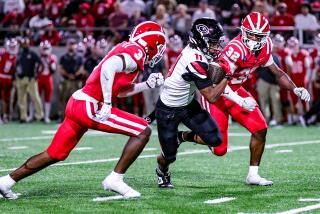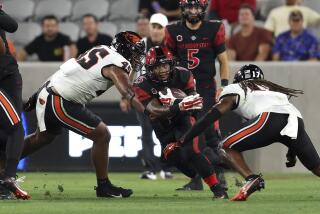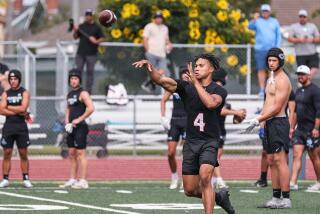LONG BEACH STATE NOTEBOOK / JASON REID : Pyramidâs Success May Help Football Return to the Field
Fiscal realities and alumni emotions rarely coincide, as anyone who has spent at least one day in an athletic directorâs chair can attest. But difficult decisions still must be made, even at the risk of angering those who sign donation checks.
Such was the situation in 1991 when Long Beach State Athletic Director Dave OâBrien killed the 49ersâ football program. OâBrien likes the game just fine, but that wasnât the issue. Supporting football was strangling the already financially troubled department.
âWe had no choice,â OâBrien said. âIf we didnât [cut football], we wouldnât have anything left today.â
It made sound financial sense to cut football then. But with Long Beach athletics riding its greatest crest, doesnât football in some form belong in the picture?
âI think [the administration] could see football returning in the future,â OâBrien said. âHowever, it would have to occur in a very prudent manner. There are a number of conditions that would have to be met to have that happen and, quite frankly, weâre not there yet.â
As with everything else at Long Beach, the Pyramid is a key. The Pyramid must be completed before reinstating football can be discussed even casually by 49er decision-makers.
If football is to return, that program will desperately need revenue from a completed and consistently sold out Pyramid.
âThereâs no question about that,â OâBrien said.
Building an on-campus stadium would be the next step. Long Beach Veterans Stadium formerly was the 49ersâ home, but it didnât create an atmosphere to help support attendance.
OâBrien believes it is necessary for students, faculty and alumni to feel involved in the sights and sounds of college football.
âWe would need to build a small, but modern, stadium on campus to make it work,â OâBrien said. âWe would have to figure out a way to do that by bringing together the various school entities.â
The toughest part would come next. Students and alumni would have to fund the program.
âThe money in the general fund would not allow us to field a football team,â he said. âOur students and alumni would have to financially support such a project. There is no doubt about it.â
Even some form of cost-containment football is expensive. An annual budget of $2 million might be on the conservative side.
Title IX issues, such as the amount of funding for womenâs athletics, would be another factor.
Additional fees assessed to students at registration likely would provide the primary funding. Increased alumni contributions and corporate sponsorships would help, but those arenât guaranteed revenue sources.
A campaign to name the Pyramid after an individual or corporate sponsor has not been as effective as university officials had hoped. And contributions often fluctuate based on a programâs success.
But taxing the students, in effect, to support football is a sensitive issue. Students have recently decried the rising cost of education in the California State University system. It took three attempts to pass a referendum to support athletics at Cal State Northridge.
OâBrien dismantled the football program to cut $465,000 from the athletic department budget. He said football accounted for $300,000.
How fierce was the backlash? Consider: Long Beach collected $300,000 in athletic contributions in the programâs final year. The figure fell to half that the year after. Today, Long Beach takes in $700,000-$800,000 in athletic contributions.
The football program wasnât exactly among the Big West Conferenceâs elite.
The 49ers were 2-9 in their final season--one of six losing seasons in the last eight years.
The late George Allen was at the controls when Long Beach experienced its only viable success during that span. He guided the 49ers to a 6-5 record in 1990.
There was talk, albeit cautious, of building the much-desired on-campus stadium. Athletic donations reached $400,000 for the first time.
But the renaissance period ended abruptly. Allen died on New Yearâs Eve in 1990. Although it is unlikely he could have saved the program, his personality might have helped delay its death.
However, whether football returns wonât have much to do with personalities. Money is key. OâBrien isnât committing himself, but one gets the sense he wants to give it a try . . . someday.
âThere are some very formidable challenges we would have to meet,â OâBrien said. âBut we built the Pyramid under some very formidable challenges.â
*
Painful time: Misty May, a highly regarded freshman setter, dislocated her right shoulder in volleyball practice Tuesday night and is out indefinitely.
May, considered by many volleyball observers to be the nationâs top high school senior at Newport Harbor, landed awkwardly on the shoulder during drills. May leads the 49ers with 337 assists and an average of 10.21 per game.
âMisty has been improving daily and has already positioned herself as our team leader,â Coach Brian Gimmillaro said. âThis is a major loss.â
Mayâs injury comes on the heels of other bad news for the 49ers. Kristin Harris, a standout sophomore outside hitter, will seek a medical redshirt season from the NCAA because of a problem with her left knee.
Backup setter Lori Price, a sophomore, has missed practice this week attending a funeral in Arizona. Fifth-ranked Long Beach (8-1, 4-0 in the Big West) plays host to Cal State Fullerton on Friday and No. 20 UC Santa Barbara on Saturday.
49er Notes
Senior outside hitter Brita Schwerm leads the volleyball team with 150 kills in 33 games, an average of 4.55 per game. . . . Senior offensive player Kip Parsons (Villa Park High) leads the water polo team with 12 goals. The team (3-3, 0-1 in the Mountain Pacific Sports Federation) is ranked seventh. Coach Ken Lindgren needs only four victories to reach 300 in his career (296-273-3).
More to Read
Go beyond the scoreboard
Get the latest on L.A.'s teams in the daily Sports Report newsletter.
You may occasionally receive promotional content from the Los Angeles Times.










